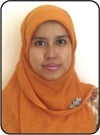The Evolution of Indonesian and American Science Education Curriculum: A Comparison Study
Abstract
ABSTRACT: Curriculum reform is an important strategy to improve the quality of education and human resources in order to increase economic development to better compete in a globalized world. This paper focuses on curriculum development in Indonesia, comparing Indonesian school curriculum to USA (United States of America) school curriculum, and analyzes several factors that strongly influenced Indonesian and American curriculum design and curriculum decision-making. Curriculum development in Indonesia, from independence in 1945 to today, is characterized by cycles of planning and revision. Currently, the goal of the new curriculum requires students to be able to appreciate and implement honesty, discipline, responsibility, compassion (tolerance and working together) and politeness, self-confidence, and effective interactions in social and natural environments. Science curriculum development in the USA schools started with private educational religious institutions. Nowadays, students are encouraged to use scientific information to make choices about issues that arise in everyday life, engage intelligently in public discourse, and debate about important issues that involve science and technology. Several aspects must be taken into account in order to reform the science education curriculum, especially in Indonesia. In designing curriculum, decision makers should involve many parties, such as higher education, researchers, politicians, scientists, teachers, parents, social and religious community leaders, and industrialists.
KEY WORDS: Curriculum Development; Science Education; Indonesian and American; Curriculum Design; Curriculum Implementation.


About the Authors: Risa Haridza, M.A. is an Educational Authorities of Pontianak City, Public Middle School 3 Pontianak, Jalan Kalimantan 123, Pontianak 78116, West Borneo, Indonesia. Karen E. Irving, Ph.D. is an Associate Professor at the Department of Teaching and Learning, College of Education and Human Ecology OSU (Ohio State University), 1945 North High St Columbus, Ohio 43210, USA (United States of America). Corresponding author: haridza.1@osu.edu
How to cite this article? Haridza, Risa & Karen E. Irving. (2017). “The Evolution of Indonesian and American Science Education Curriculum: A Comparison Study” in EDUCARE: International Journal for Educational Studies, Vol.9(2), February, pp.95-110. Bandung, Indonesia: Minda Masagi Press owned by ASPENSI, ISSN 1979-7877.
Chronicle of the article: Accepted (September 8, 2016); Revised (January 15, 2017); and Published (February 27, 2017).
Keywords
Full Text:
PDFReferences
AAAS [American Association for the Advancement of Science]. (1989). Project 2061: Science for All Americans. Washington, D.C.: Author.
Aldridge, B.G. (1992). Project on Scope, Sequence, and Coordination: A New Synthesis for Improving Science Education” in Journal of Science Education and Technology, 1, pp.13-21.
Bjork, C. (2003). “Local Responses to Decentralization Policy in Indonesia” in Comparative Education Review, 47(2), pp.184-216.
Bjork, C. (2004). “Decentralization in Education, Institutional Culture, and Teacher Autonomy in Indonesia” in International Review of Education, 50, pp.245-262.
Blum, A. (1979). “Curriculum Adaptation in Science Education: Why and How” in International Science Education, 63(5), pp.693-704.
Bybee, R.W., J.C. Powell & L.W. Trowbridge. (2008). Teaching Secondary School Science. Columbus, Ohio: Pearson.
Cheng, V.M.Y. (2010). “Teaching Creative Thinking in Regular Science Lesson: Potentials and Obstacles of Three Different Approaches in an Asian Context” in Asia-Pacific Forum on Science Learning and Teaching, 11(1), pp.1-21.
Cuban, L. (1984). How Teachers Taught. New York: Longman Inc.
DeBoer, G. (1991). A History of Ideas in Science Education. New York: Teacher College Press.
DeBoer, G. (2000). “Scientific Literacy: Another Look at Historical and Contemporary Meanings and its Relationship to Science Education Reform” in Journal of Research in Science Teaching, 37(6), pp.582-601.
de Ree, Joppe et al. (2016). “Double for Nothing? Experimental Evidence on the Impact of an Unconditional Teacher Salary Increase on Student Performance in Indonesia”. Available online at: https://www.povertyactionlab.org/sites/default/files/publications/166%20Teacher%20Salary%20Increase%20Indonesia%20Jan2016.pdf [accessed in Pontianak City, Indonesia: January 11, 2017].
Dharma, Agus. (2008). “Indonesian Basic Education Curriculum: Current Content and Reform”. Available online at: www.vnseameo.org/downloads/malay/indonesia.doc [accessed in Pontianak City, Indonesia: September 15, 2016].
DoE [Department of Education] Ohio. (2011) “Ohio’s New Learning Standards: Science Standards”. Available online at: http://education.ohio.gov/getattachment/Topics/Ohios-Learning-Standards/Science/ScienceStandards.pdf.aspx [accessed in Pontianak City, Indonesia: September 15, 2016].
Drost, J.I.G.M. (1998). Sekolah: Mengajar atau Mendidik? Yogyakarta: Penerbit Kanisius.
Duschl, R. (2012). “The Second Dimension — Crosscutting Concepts: Understanding a Framework for K-12 Science Education” in The Science Teacher, 79, pp.34-38.
Eisner, E.W. (1979). The Educational Imagination. New Jersey: Prentice Hall.
Falak, Samsul. (2014). “The Changing of Curriculum from 2006 to 2013”. Available online at: http://bdksemarang.kemenag.go.id/the-changing-of-curriculum-from-2006-to-2013/ [accessed in Pontianak City, Indonesia: September 15, 2016].
Firman, H. & B. Tola. (2008). “The Future of Schooling in Indonesia” in Journal of International Cooperation in Education, 11(1), pp.71-84.
Ganimian, A.J. & R.J. Murnane. (2016). “Improving Education in Developing Countries: Lessons from Rigorous Impact Evaluations” in Review of Educational Research, 86(3), pp.719-755.
Gaylord, W.A. (2008). “Reformasi and Teachers’ Implementation on Civic Education in West Sumatra, Indonesia”. Unpublished Ph.D. Dissertation. Indiana: Faculty of Graduate School at the Indiana University USA [United States of America]. Available online also at: www.ProQuest.Database [accessed in Pontianak City, Indonesia: July 3, 2016].
“Goals for Science Education”. Available online at: https://www.nap.edu/read/11625/chapter/4 [accessed in Pontianak City, Indonesia: September 15, 2016].
Hamalik, O. (1993). Model-model Pengembangan Kuriculum. Bandung: PPs IKIP [Program Pascasarjana, Institut Keguruan dan Ilmu Pendidikan] Bandung.
Kemdikbud RI [Kementerian Pendidikan dan Kebudayaan Republik Indonesia]. (2013). “Kerangka Dasar dan Struktur Kurikulum Sekolah Menengah Kejuruan dan/atau Madrasah Aliyah Kejuruan”. Available online at: http://www.balitbang.kemdikbud.go.id [accessed in Pontianak City, Indonesia: September 15, 2016].
Kemdikbud RI [Kementerian Pendidikan dan Kebudayaan Republik Indonesia]. (2014). Materi Pelatihan Implementasi Kurikulum 2013 Tahun Ajaran 2014/2015. Jakarta: Pusat Pengembangan Profesi Pendidik Badan Pengembangan Sumber Daya Manusia, Pendidikan dan Kebudayaan dan Penjaminan Mutu Pendidikan.
Khoiriyah, Umatul et al. (2015). “Enhancing Students’ Learning in Problem Based Learning: Validation of a Self-Assessment Scale for Active Learning and Critical Thinking” in BMC Medical Education, 15. Available online also at: https://www.ncbi.nlm.nih.gov/pmc/articles/PMC4549835/ [accessed in Pontianak City, Indonesia: September 15, 2016].
Koul, A. (2014). “Impact of Innovative Approaches in Teaching-Learning of Science on Rural Students at Middle School Level” in Asia-Pacific Forum on Science Learning and Teaching, 15(2), pp.1-30.
Lederman, L. (2003). Science Literacy for the Twenty-First Century. New York: Prometheus Books.
Lewin, K. (1985). “Quality in Question: A New Agenda for Curriculum Reform in Developing Countries” in Comparative Education, 21(2), pp.117-133.
Madya, Suwarsih. (2010). “Curriculum Innovations in Indonesia and the Strategies to Implement Them”. Available online at: file:///C:/Users/acer/Downloads/Asia [accessed in Pontianak City, Indonesia: November 7, 2016].
Maitland, Christine. (2007). “NEA Higher Education: 150 Years and Growing”. Available online at: http://www.nea.org/assets/img/PubThoughtAndAction/TAA_07_08.pdf [accessed in Pontianak City, Indonesia: November 7, 2016].
Mansour, N. (2009). “Science-Technology-Society (STS): A New Paradigm in Science Education” in Bulletin of Science, Technology & Society, 29(4), pp.287-297.
Marsh, C.J. & G. Willis. (2007). Curriculum: Alternative Approaches, On Going Issues. Columbus, Ohio: Pearson Education.
MoNE [Ministry of National Education]. (2003a). “Main Strategies in National Education Development in Indonesia Education System”. Available online at: http://www.pdk.go.id [accessed in Pontianak City, Indonesia: November 7, 2016].
MoNE [Ministry of National Education]. (2003b). “Indonesia Second Twenty-Five-Year-Development Plan (PJP 1994/1995 — 2018/2019)”. Available online at: http://www.pdk.go.id [accessed in Pontianak City, Indonesia: November 7, 2016].
Mulyasa, E. (2006). Kurikulum Berbasis Kompetensi: Konsep, Karakteristik, dan Implementasi. Bandung: PT Remaja Rosdakarya.
NCSESA [National Committee on Science Education Standards and Assessment]. (1996). “National Science Education Standards”. Available online at: http://www.nap.edu/catalog.php?record_id=4962 [accessed in Pontianak City, Indonesia: January 11, 2017].
NGSS [Next Generation Science Standards] Lead States. (2013). Next Generation Science Standards: For State, by States. Washington D.C.: The National Academies Press. Available online also at: http://www.nap.edu [accessed in Pontianak City, Indonesia: January 11, 2017].
Nishimura, Shigeo. (1995). “The Development of Pancasila Moral Education in Indonesia” in Southeast Asian Studies, Vol.33, No.3 [December]. Available online also at: https://kyoto-seas.org/pdf/33/3/330302.pdf [accessed in Pontianak City, Indonesia: January 11, 2017].
NRC [National Research Council]. (1996). National Science Education Standards. Washington, D.C.: National Academy Press: Available online also at: http://books.nap.edu/catalog/4962.html [accessed in Pontianak City, Indonesia: September 7, 2016].
NRC [National Research Council]. (2012). A Framework for K-12 Science Education: Practices, Crosscutting Concepts, and Core Ideas. Washington, D.C.: National Academy Press. Available online also at: http://www.nap.edu/catalog.php?record_id=13165 [accessed in Pontianak City, Indonesia: January 11, 2017].
OECD [Organization for Economic Cooperation and Development]. (2015). “Working Age Population: Indicator”. Unpublished Paper. DOI: 10.1787/d339918b-en (October 26).
Parker, L. & R. Raihani. (2011). “Democratizing Indonesia through Education? Community Participation in Islamic Schooling” in Educational Management Administration and Leadership, 39(6), pp.712-732.
Peddiwell, J.A. (1939). Saber Tooth Curriculum. New York: McGraw Hill Book.
Power, Lorna & Joseph Cohen. (2015). “Competency-Based Education and Training Delivery: Status, Analysis and Recommendations”. Available online at: http://datatopics.worldbank.org/hnp/files/edstats/IDNdprep05.pdf [accessed in Pontianak City, Indonesia: September 7, 2016].
Reiser, B., L. Berland & L. Kenyon. (2012). “Engaging Students in the Scientific Practices of Explanation and Argumentation: Understanding a Framework for K-12 Science Education” in The Science Teacher, 79(4), pp.8-13.
Rubba, P.A. & R.L. Wiesenmayer. (1991). “A Student of the Qualities Teachers Recommend in STS Issue Investigation and Action Instructional Materials” in Bulletin of Science, Technology & Society, 11, pp.212-219.
Sadiman, Arief S. (2009). “Challenges in Education in Southeast Asia”. Available online at: http://www.seameo.org/vl/library/dlwelcome/publications/paper/india04.htm [accessed in Pontianak City, Indonesia: September 7, 2016].
Safrudiannur. (2015). “Is Mathematics Textbook Published by the Ministry of Education and Culture of Indonesia Feasible Based on Mathematics Teachers‘ Perceptions?” in Jurnal ©Pancaran, Vol.4, No.1 [February], pp.1-10. Available online also at: http://webcache.googleusercontent.com/search?q=cache:http://jurnal.unej.ac.id/index.php/pancaran/article/viewfile/1304/1064 [accessed in Pontianak City, Indonesia: September 7, 2016].
Saputri, Mawarni. (2014). “History of Curriculum Development in Indonesia”. Available online at: http://putriiymawar.blogspot.co.id/2014/07/history-of-curriculum-development-in_7006.html [accessed in Pontianak City, Indonesia: September 7, 2016].
Sato, Yuri. (2003). “Deomocratizing Indonesia: Reformasi Period in Historical Perspective”. IDE Research Paper, No.1 [August]. Available online also at: http://www.ide.go.jp/English/Publish/Download/Papers/pdf/01_01.pdf [accessed in Pontianak City, Indonesia: September 7, 2016].
Schmidt, W.H. et al. (2001). Why School Matters. San Fransisco: Jossey-Bass.
Somerset, T. (1988). “The PKG System for Teacher Improvement”. Unpublished Report for the Indonesian Ministry of Education and Culture in Jakarta, Indonesia.
Spring, J. (2008). American Education. New York: McGraw Hill.
Suparno, Paul. (2017). “Pluralistic and Multicultural Education in the Indonesian Schools” in IJIET: International Journal of Indonesian Education and Teaching, Vol.1(1), January. Available online also at: file:///C:/Users/acer/Downloads/328-838-1-PB.pdf [accessed in Pontianak City, Indonesia: January 11, 2017].
Suprihatiningrum, J. (2012). “The Development of Local Content-Based Science Curriculum for Madrasah Tsanawiyah (Islamic Middle School) in Yogyakarta, Indonesia” in International Journal of Education Curriculum Section, 2, pp.254-265.
Sutisna, A. (2011). Sejarah Perkembangan Kurikulum. Bandung: PPs UPI [Program Pascasarjana, Universitas Pendidikan Indonesia].
Taniredja, T., M. Afandi & E.M. Faridli. (2012). “The Appropriate Pancasila Education Contents to Implant Lofty Values for Indonesian Students” in EDUCARE: International Journal for Educational Studies, 5(1). Available online also at: http://research.unissula.ac.id/research/file/publikasi/211313015/6732Jurnal_internasional.pdf [accessed in Pontianak City, Indonesia: January 11, 2017].
Thair, M. & D.F. Treagust. (1997). “A Review of Teacher Development Reforms in Indonesian Secondary Science: The Effectiveness of Practical Work in Biology” in Research in Science Education, 27(4), pp.581-597.
Thomas, R.M. (1991). “Curriculum Development in Indonesia” in C. Marsh & P. Morris [ed]. Curriculum Development in East Asia. London: The Falmer Press, pp.202-214).
Torar, L. & Wahono. (2016). The Management of National Education in 2014/2015 at a Glance Compiled. Jakarta: Center for Educational and Cultural Data and Statistics MoEC [Ministry of Education and Culture]. Available online also at: http://publikasi.data.kemdikbud.go.id/uploadDir/isi_6549DA84-7A7F-44B5-AD22-829B1F002A4F_.pdf [accessed in Pontianak City, Indonesia: January 11, 2017].
Utomo, E. (2005). “Challenges of Curriculum Reform in the Context of Decentralization: The Response of Teacher to a Competence-Based Curriculum (CBC) and its Implementation in Schools”. Unpublished Ph.D. Dissertation. Pittsburgh: Graduate Faculty of the School of Education at the University of Pittsburgh. Available also at: www.ProQuest.database [accessed in Pontianak City, Indonesia: September 7, 2016].
Wirianto, D. (2014). “Perspektif Historis Transformasi Kurikulum di Indonesia” in Islamic Studies Journal, 2(1), pp.134-147.
Yeom, M., C. Acedo & E. Utomo. (2002). “The Reform of Secondary Education in Indonesia during 1990s: Basic Education Expansion and Quality Improvement through Curriculum Decentralization” in Asia Pacific Education Review, 3(1), pp.56-68.
Yeung, Y., Y. Lee & I. Lam. (2012). “Curriculum and Reform and Restructuring of Senior Secondary Science Education in Hong Kong: Teachers’ Perceptions and Implications” in Asia-Pasific Forum on Science Learning and Teaching, 13(2), pp.1-33.
EDUCARE: International Journal for Educational Studies. Ciptaan disebarluaskan di bawah Lisensi Creative Commons Atribusi-BerbagiSerupa 4.0 Internasional
